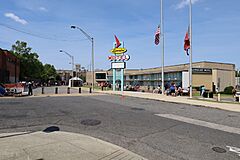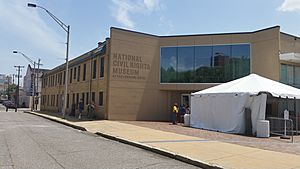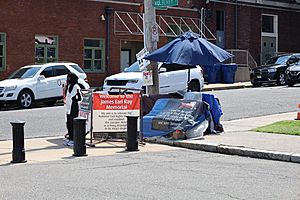National Civil Rights Museum facts for kids
The National Civil Rights Museum is a special place in Memphis, Tennessee. It's a group of museums and historic buildings that tell the story of the civil rights movement in the United States. This movement was a time when people worked hard to gain equal rights for all, especially for African Americans.
The museum is built around the famous Lorraine Motel. This motel is important because it's where Martin Luther King Jr. was sadly assassinated in 1968. The museum shows how the fight for civil rights has changed from the 17th century until today.
After some big updates, the museum reopened in 2014. It now has many interactive displays, videos, and short films to help visitors understand this important history. The museum is run by a group called the Lorraine Civil Rights Museum Foundation. In 2016, it became a partner museum with the Smithsonian Institution, which is a big honor!
Quick facts for kids |
|
|
National Civil Rights Museum
|
|
|
U.S. Historic district
Contributing property |
|

View from southwest in 2022
|
|
| Location | Memphis, Tennessee |
|---|---|
| Built | 1924 |
| Part of | South Main Street Historic District (ID82004054) |
| Added to NRHP | 1982 |
Contents
Exploring the Museum Complex
The National Civil Rights Museum is located at 450 Mulberry Street in Memphis. Most of the buildings are owned by the museum's foundation. However, the Lorraine Motel itself is owned by the state of Tennessee. The foundation operates the motel as part of the museum under a long-term agreement.
Historic Buildings and Exhibits
The main museum is in downtown Memphis, near the Mississippi River. The museum complex includes the Lorraine Motel and other important buildings. One of these is the Young and Morrow Building. This is where James Earl Ray first said he shot Dr. King, though he later changed his story. Next door is Canipe's Amusement Store, where the weapon used in the shooting was found. The museum also includes the empty lot between these buildings and the motel.
Vehicles of History
Inside and outside the museum, you can see several vehicles that played a role in history.
- An International Harvester garbage truck is part of an exhibit about the 1968 Memphis sanitation strike. Dr. King came to Memphis to support these striking workers.
- You can see James Earl Ray's 1966 white Ford Mustang.
- A 1968 Cadillac and a 1959 Dodge are parked outside the motel, just as they might have been in 1968.
- There's a replica of a burned Greyhound bus. This reminds visitors of the Freedom Riders, who faced violence while protesting segregation on buses.
- Another bus represents the Montgomery bus boycott, a major event in the civil rights movement.
The Lorraine Motel's Story
The building that became the Lorraine Motel first opened in 1924 as the Windsor Hotel. It was later called the Marquette Hotel. In 1945, Walter Bailey bought it and named it after his wife, Loree, and a song called "Sweet Lorraine".
A Welcoming Place During Segregation
During the time of segregation, many businesses separated people by race. The Lorraine Hotel was special because it offered nice rooms for Black travelers. After the Civil Rights Act of 1964 made segregation illegal, Mr. Bailey expanded the hotel. He added a second floor, a swimming pool, and more rooms. He then changed the name to the Lorraine Motel. Many famous musicians stayed there in the 1960s, including Ray Charles, Aretha Franklin, and Otis Redding. They were often recording music at nearby Stax Records.
The Assassination of Martin Luther King Jr.
Civil rights movement leader Martin Luther King Jr. stayed in Room 306 at the Lorraine Motel in April 1968. He was in Memphis to support sanitation workers who were on strike. On the evening of April 4, Dr. King was standing on the balcony outside his room. He was shot by an assassin and fell to the ground. He was quickly taken to the hospital but sadly died an hour later. He was only 39 years old.
A man named James Earl Ray was convicted of Dr. King's murder in 1969. Ray pleaded guilty but later said he didn't do it. Many people, including Dr. King's family, believe that Ray was not the only person involved. They think there might have been a larger group of people, or even government agents, involved in the assassination.
Soon after Dr. King's death, people wanted to create a memorial at the Lorraine Motel. His wife, Coretta, and his friend Ralph Abernathy unveiled a special plaque there. Room 306 was turned into a shrine to honor Dr. King's memory.
Creating the Museum
After Dr. King's death, the motel faced financial problems. But many people still visited the site to remember him. In the early 1980s, local leaders worked to save the motel from being sold. A new non-profit group, the Martin Luther King Memphis Memorial Foundation, was formed. They worked hard to raise money to buy the motel. In 1982, the motel was added to the National Register of Historic Places.
The foundation eventually bought the motel and changed its name to the Lorraine Civil Rights Museum Foundation. They wanted to turn the building into a museum. It took many years and a lot of effort to raise the money needed. In 1987, the foundation partnered with the state of Tennessee and the city of Memphis to develop the museum. The motel closed to guests in 1988, and the state took ownership.
Jacqueline Smith's Protest
When the motel closed, one person who lived there, Jacqueline Smith, did not want to leave. She had lived at the motel since 1973 and worked there. Ms. Smith believed that Dr. King would have wanted money to be spent on helping poor people in the neighborhood, not on a fancy museum. She felt that building the museum was part of making the area more expensive, pushing out people who lived there.
Ms. Smith stayed at the closed motel for several weeks. She was eventually asked to leave by authorities. She then began a protest vigil outside the museum, which has continued for many years. She has spoken to thousands of visitors, sharing her views. Even former president Jimmy Carter visited the site and listened to her. Ms. Smith believes the museum should focus more on Dr. King's dream of equality and less on the sad event of his death.
The Museum Opens
The Foundation worked with experts to design a museum that would save the historical parts of the motel. A new, modern museum was built on other parts of the property. The museum officially opened to the public on September 28, 1991.
In 1999, the museum acquired the Young and Morrow Building and the empty lot next to it. A tunnel was built under the lot to connect this building to the motel. The museum also became the keeper of police files and evidence from the assassination, including the rifle and the bullet. These items are now on display in an exhibit in the former Young and Morrow building, which opened in 2002.
Updates and Renovations
In 2012, the main museum closed for a big renovation project. This $27.5 million update brought new exhibits and improved the building. Experts on civil rights helped make sure the exhibits were accurate and powerful. Some popular exhibits stayed the same, like Room 306 and the replica sanitation truck. The replica of the bus from the Montgomery bus boycott also remained.
When the museum reopened in 2014, it featured a new exhibit: a replica of the U.S. Supreme Court room. Here, visitors can learn about the important 1954 case of Brown v. Board of Education. In this case, the Court ruled that separating students by race in public schools was against the law. This was a huge victory for the civil rights movement.
The renovated museum also has many interactive stations. Visitors can use headphones to listen to audio, see images, read text, and watch videos about the civil rights movement. You can search for information by event, location, or theme. More than 40 new short films throughout the museum help bring the history to life.
Images for kids
See also
 In Spanish: Museo Nacional de Derechos Civiles para niños
In Spanish: Museo Nacional de Derechos Civiles para niños






